Carpenter Secret Love Songs
Trombone Quartets

-
Carpenter
Secret Love Songs
Marriages in the thirteenth century court were largely dynastic. The troubadour's role was, by means of poetry and music, to fulfil the romantic dreams of the housebound wife whose husband would be off killing people in the Holy Land or to send covert messages from would-be suitors to those same young women whose arranged marriages made them essentially unobtainable anyway.
The title Secret Love Songs works on two levels depending on emphasis: a contemporary analogue of the troubadour song where friendships that remain close and long but which, for whatever reason, never cross the line into romance, are celebrated; or to a recurrent dramatic situation in "One Two." an ongoing opera project with the poet Eva Salzman where duality is the idee fixe against which a number of covert assignations are played out.
Secret Love Songs is in six movements that are grouped into two groups of three where the first two in each group are played without a break. Songs 3 and 6 quote a Rondeau by the troubadour Adam de la Halle entitled Chant Con Je Vivrai. Material from the opera One Two is woven into the texture of Songs 5 and 6 in particular. Phrases and chords from Song 1 re-appear in various guises throughout all the other songs and so generate a Theme and Variations in parallel. The first three songs make considerable use of glissandi and other specifically trombonistic effects whilst the last three use glissandi sparingly, but do exploit several different types of mute in a meaningful sort of way. All titles and texts apart from de la Halle's are from One Two and are used with Eva Salzman's kind permission. --the publisher -
- Category: Trombone Quartets
- Item: 052137
- Grade/Level:
- Price: $49.95
-
(usually ships in 20 to 30 days)
